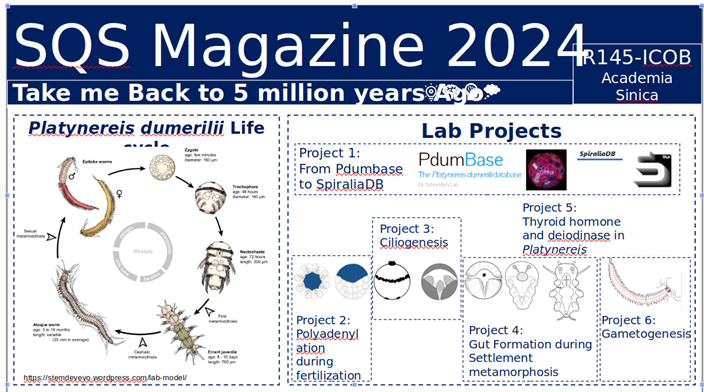Platynereis is a bilaterally symmetric polychaete annelid with an ancient body plan that develops rapidly. A single female Platynereis spawns thousands of 160-μm eggs that are all fertilized at the same time. Then, the thousands of embryos from a single mating develop synchronously through embryonic and larval stages. By 24 h, the embryos develop into a free-swimming larval form, and after just 96 h, Platynereis is a three-segmented juvenile worm that stays on the bottom of the dish. The worm keeps adding segments at its tail end throughout its life, growing longer and longer.
Adult Platynereis starts to transform and reveal genders shortly before it sexually matures. Worms becoming males turn red and generate sperms, while females turn yellow, and eggs are produced and stored in their body cavity.
When the lunar cycle is just right, Platynereis will mate by performing a certain ritual of swimming in circles. The female swims in small circles while the male swims around it in larger circles. The female and male release their eggs and sperm at the same time to create thousands of offspring. Once mating is completed, both of the adults will die.
Platynereis can be collected from the coasts of the Mediterranean Sea or Western Europe. In the lab, it can be easily cultured. As a marine creature, the worms need seawater, and it is best to use filtered natural seawater. The young and adult worms are fed with minced organic spinach on Mondays and ground fish food flakes on Fridays. The speed of early development is very temperature sensitive, so labs around the world that study Platynereis keep them in rooms at a constant temperature of 18°C. Light is very important for the worms because their sexual maturity and spawning are synchronized by the lunar cycle. In the lab, the worms are kept in a constant summer schedule that has 16 hours of light and 8 hours of darkness each day. The dark periods follow a 28-day night cycle with three weeks of dark nights followed by 7-days of a simulated full moon.
Many laboratories that study Platynereis are interested in developmental biology or evolutionary developmental biology. Some labs study topics such as eye and brain development, or how the moon affects the life cycle of Platynereis. At ICOB, the Schneider lab focuses on understanding how gene expression is regulated in early Platynereis embryos and how those genes control its development.
In one project they are studying how genes and proteins control ciliogenesis. During ciliogenesis, a long antenna, called a cilium, is extended from the cell. This structure may serve a few different functions depending on the type of cell. For example, it could be used to move the cell, such as with sperm, or it can be used to sense the environment or receive signals from other cells. During development, cilia formation is especially important for creating left-right asymmetric structures in many species, and incorrect cilia formation in human cells can cause several health conditions, including some types of kidney disease, heart disease, and blindness. It may be surprising that studying such tiny ocean creature can help us better understand human disease.
